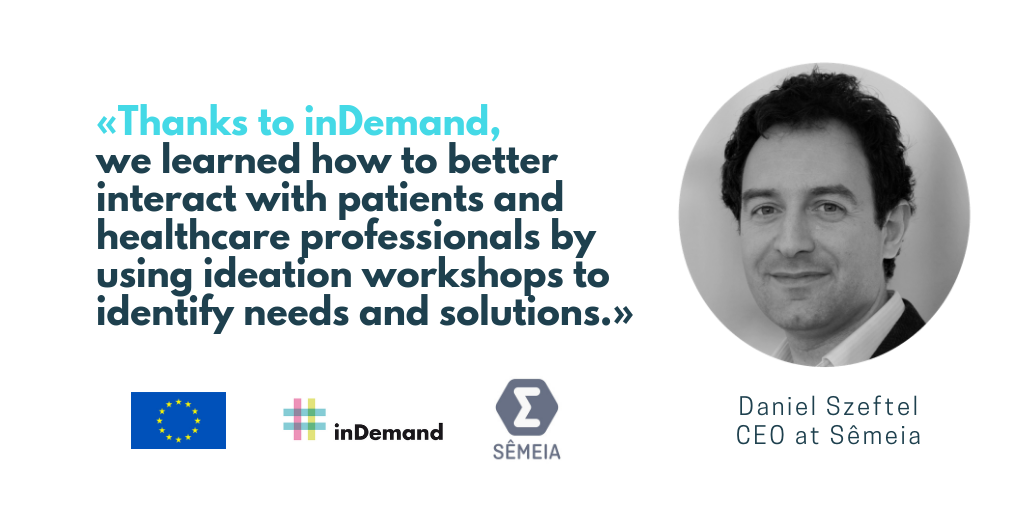Data in hospitals avoid unnecessary hospitalisation
Have you heard about the «tunnel effect»? In some cases, after patients leave the hospital, the practitioners do not know what is happening until the next consultation. This means they can’t anticipate complications or avoid unnecessary hospitalisation. In order to improve the state of the patient’s health and the healthcare professionals job, Semeia has worked in an AI-driven disease management solution.
This company was selected to solve a need detected by the Foch Hospital in Paris (France) – «SafeFoch: Remote monitoring of real-life patient data to anticipate the occurrence of complications / degradations in health status.»
Know more about this inDemand success case!

1.- Sêmeia at a glance
Sêmeia offers an AI driven disease management solution to support patients with chronic and acute conditions. Our solution is a multi-channel disease management digital tool aimed at delivering Just-in-Time, Adaptive Interventions (JITAIs) from practitioners to increase patient adherence to treatments and care pathways.
2.- What was the need detected by the healthcare professionals?
The Foch Hospital wanted to improve its follow-up of renal transplant patients. After patients leave the hospital, hospital practitioners are victims of the “tunnel effect”: they do not know what is happening until the next consultation. Having data on these patients in real time between two visits to the hospital would allow practitioners to anticipate complications, adjust prescriptions, avoid unnecessary hospital visits (emergencies, hospitalisation) and obviously improve the state of the patient’s health.
3.- How did you propose to solve it?
To address this challenge, Sêmeia has created a multi-channel disease management digital solution aimed at helping nephrology care teams to increase transplanted patient compliance to treatments and care pathways, thus avoiding hospitalizations, unneeded healthcare utilization and graft failures.
Our solution relies on predictive algorithms based on the analysis of the French NHS claims database where thousands of renal transplant patients health utilization and health status data can be analysed. Artificial intelligence techniques are used to build algorithms to identify patients at higher risk of non-adherence, readmission and graft failure in order to target high risk/high need/high costs patients that would be require proactive and/or intensive action from practitioners, target care episodes where patients are at high risk of readmission and/or graft failure to intensify follow-up and identify relevant data to collect in real-time in order to prevent readmissions and graft failure.
4.- How do you feel about co-creation? Harder/easier than expected, teamwork benefits…
The co-creation process was very helpful in gathering in record time all the key insights we needed from the healthcare team, the patients and the hospital administration. Their involvement has allowed us to build a solution that truly answer users needs and expectations.
5.- Main learnings from the inDemand process
We learned how to better interact with patients and healthcare professionals by using ideation workshops to identify needs and solutions, prototyping workshops to design our digital solution and continuous testing to improve the user experience.
6.- What is your go-to-market approach? Why has the business support received been useful?
Bringing to market an innovative solution to better follow-up renal transplant patients gave us the opportunity to enter an experimental payment scheme initiated by the French NHS to cover telemonitoring initiatives in key chronic conditions.
«Business support provided through the inDemand process helped us rethinking our approach towards hospitals and care teams.»
7.- Why do you think digital transformation on healthcare pays off?
Through the use of artificial intelligence, predictive modelling and digital intervention, it is possible to offer personalized support programs to patients adapted to their profile and their needs where human interventions will be reserved for the situations for which they are really necessary.
We believe that this kind of data-driven patient engagement programs are one of the main answers to challenges facing today’s healthcare systems: demographic age shifting, rapid increase in chronic disease incidence, lower density of available healthcare professionals, and non-sustainable financial burden for social security systems.
